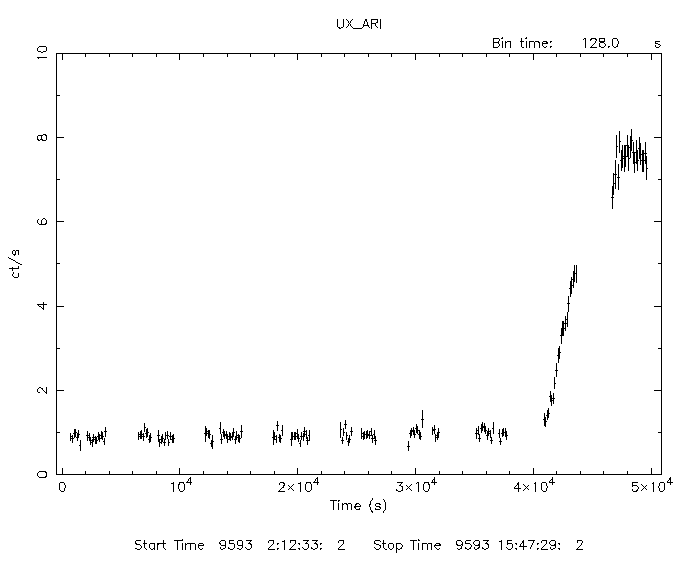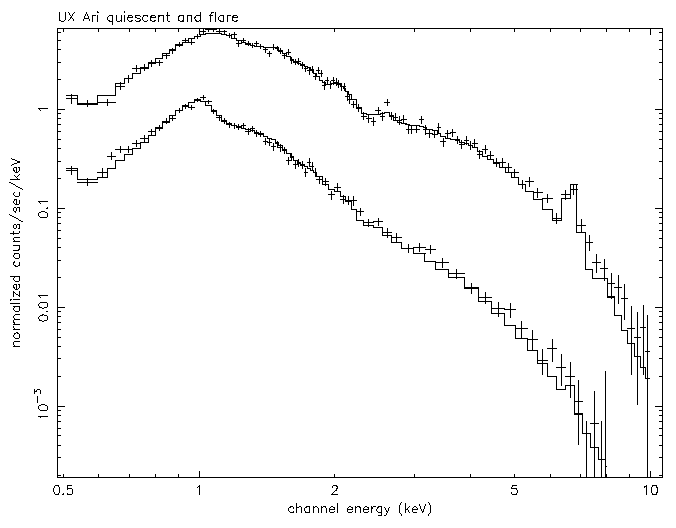Stars
ASCA has observed a wide variety of normal stars, both single and within binary systems, spanning the range of stellar masses from massive O stars to low mass late M dwarfs. These observations have probed the properties of hot X-ray emitting plasma around stars at all evolutionary stages, including the pre-main-sequence, main sequence, and post-main sequence phases. Stellar coronae, present on most cool stars, are strong sources of X-ray continuum and line emission. For many stars this emission originates from plasma confined and heated within magnetic structures. However, massive O and B stars are believed to emit X-rays from shocks generated in their stellar winds.Atomic Physics
The soft X-ray spectra of both cool and hot stars are generally modeled using optically thin, collisionally ionized thermal plasma (aka `coronal plasma') models. These models are suspected of having omissions or errors in the atomic data and/or ionization equilibrium for important ions, particularly for the L shell line complexes of the more complex Fe and Ni ions. Modeling of ASCA spectra of some bright coronal sources such as Capella using these codes has revealed some gross mismatches in specific spectral regions between the observed and the model spectra (e.g., see Fig. 2 of Drake 1996, in Cosmic Abundances, p. 215) that have helped atomic physicists to identify ionic species whose emission is probably being miscalculated (Brickhouse et al. 1997, AAS HEAD Meeting poster).Coronal Temperature Distributions
ASCA is sensitive to emission from plasmas with temperatures from ~2 MK to > 40 MK, and, in particular, is able to measure the temperatures of hot (> 10 MK) coronae more accurately than other previous or extant instruments. As a result ASCA has detected very hot coronal plasmas, that have higher temperatures than measured with lower resolution data from satellites such as Einstein and ROSAT. This sensitivity to high temperature continuum emission and the ability to definitively measure the emission in the He-like Fe XXV lines at 6.7 keV are major observational capabilities of ASCA that contribute immensely to multi-spectral region analyses of coronal thermal distributions. Studies of ASCA spectra typically require multi-temperature coronal emission measure distributions in order to obtain adequate fits. Generally, such analyses have taken the form of global fitting of the spectra against 1-, 2-, or 3-temperature emissivity models with variable elemental abundances. The coronae of active binary stars, such as RS CVn and Algol binaries, are found to contain very hot plasma. Hot emission is also seen from single evolved giants and supergiants, e.g. 31 Com (G0 III) and other moderate mass giants at 20 and 8 MK (Ayres et al. 1998 ApJ 496, 428) and beta Dra (G2 Ib-II) at 1.6 and 0.7 keV (19 and 8 MK) (Skinner & Brown 1996). Drake et al. (1994 ApJ 436, L87) found lower temperatures of 0.3-0.4 and 0.7 keV for the G dwarf pi^1 UMa and the late-G giant beta Cet, and Mewe et al. (1998, A&A, submitted) find evidence for only a single 0.3 keV component in the coronae of the solar-age, wide binary alpha Cen. Gudel, Guinan, & Skinner (1997 ApJ 483, 947) have used a sample of nine G dwarfs to explore how coronal activity on a star like the Sun evolves over time. They find a systematic softening of the X-ray spectrum with time, with the hot 20-30 MK component that dominates the coronal emission of young active stars becoming unimportant in stars with ages over 500 Myr.


Coronal Flaring
Observations of stellar flares have been made by ASCA, often in coordination with other satellites and ground-based telescopes. For example, a large flare of the RS CVn binary UX Ari was detected during a 14-hour ASCA observation by Linsky et al. (Fig. 1; 1997, AAS, 191, 44.12) in which plasma heating to a temperature in excess of 50 MK was observed, as well as an increase of a factor of 5 of the coronal Fe abundance. Also, flares have been observed simultaneously by ASCA and EUVE of the young K dwarf star AB Dor (Mewe et al. 1996, A&A 315, 170) and of the RS CVn binaries II Peg (Mewe et al. 1997, A&A 320, 147), HR 1099 and sigma^2 CrB (Brown et al. 1997, AAS, 190, 25.09).Coronal Elemental Abundances
ASCA has provoked renewed interest in and greater understanding of the elemental abundances prevailing in coronal material. The higher spectral resolution of ASCA compared to previous high-throughput X-ray detectors has allowed abundances to be estimated not only for Fe (where in some cases a clear measurement of the Fe K-alpha feature against the surrounding continuum is possible), but also of Ca, Ar, S, Si, O, Mg, and Ni. Comparisons between theoretical emissivity models and ASCA spectra of highly active coronae have shown a pattern of Fe abundances that are either similar to or lower than the solar photospheric value by factors that range from ~1.3 to 7 (Drake et al. 1994 ApJ 436, L87; Singh et al. 1996 ApJ 456, 766; Mewe et al. A&A in press, Ortolani et al. 1997 A&A 325, 664; Singh et al. 1998). The other heavy elements, with the exception perhaps of Ni, show similar depletion factors relative to hydrogen compared to their values in the solar photosphere. The solar coronal abundances are generally believed to exhibit an overabundance of easily ionized elements like Fe, Mg, and Si compared to the photosphere, so the underabundance seen in stellar coronae is quite puzzling. The difference may be related to the fact that all of the late-type stars ASCA has observed to data have much higher coronal luminosities and temperatures than those typical of the Sun, though there is no consensus of what the fractionation mechanism might be, either for the Sun or the active stars, although recently van den Oord and Mewe (1998, in preparation) have proposed a gravitational settling mechanism that seems promising. Gudel et al. (1998, ApJ, in press) have provided new insight into the processes controlling coronal abundances from ASCA observations of a flare on the active binary UX Ari during which the Fe abundance was seen to increase from 0.17 solar to near photospheric values as (presumably) underlying photospheric and chromospheric material was evaporated to fill the flaring coronal loops.Pre-Main-Sequence Stars
ASCA observations of star formation regions and pre-main-sequence stars show the presence of unexpected amounts of hard X-ray emission. Both low-mass (`T Tauri stars') and higher-mass (`Herbig Ae/Be star') pre-main-sequence stars with low absorption columns (i.e., IR Class 2 and 3 sources) show very hot coronae with emission from plasma with temperatures of ~2-3 keV (Carkner et al. 1996 ApJ 464, 286; Skinner & Yamauchi 1996 ApJ 471, 987; Skinner et al. 1997, ApJ, 486, 886; Tsuboi et al. ApJ, in press; Yamauchi et al. 1998, PASJ, submitted). Some of these are spectral type B5-A6, for which no theory predicts X-ray emission. Massive young stars in HII regions or giant molecular clouds show X-ray emission with temperatures of 3-10 keV and emission lines from He-like Fe K (Yamauchi et al. 1996 PASJ 48, 719; Hofner and Churchwell 1997 ApJ 486, L39; Sekimoto & Torii, priv. comm.). The temperature observed is higher than that seen from massive main sequence stars, which may indicate a more violent stellar wind shock near the young stars. The high temperature plasmas in massive star forming regions can contribute to the Galactic Ridge emission.Observations of the cores of star formation regions show pervasive hard X-ray emission that appears to originate from a variety of previously known and new point sources, many of which are obscured at lower energies (Koyama et al. 1994 PASJ 46, L125; Koyama et al. 1996 Nagoya meeting, Kamata et al. 1997 PASJ 49, 461). Koyama et al. (1996, in Magnetodynamic Phenomena in the Solar Atmosphere - Prototypes of Stellar Magnetic Activity, p. 243) have detected hard X-ray emission, including a strong flare, from Class I protostellar sources in the R CrA and rho Oph molecular clouds. Such hard X-rays were not expected during the early stages of pre-main-sequence evolution and raise interesting questions about how X-ray emission and the implied magnetic fields influence the star formation process. Shu et al. (1997, Science, 277, 1475) and Hayashi et al. (1996, ApJ 468, L37) have independently proposed that the hard X-ray emission from protostars is due to magnetic interaction between the protostellar magnetic fields and the innermost regions of the accretion disks in which they are embedded. Many hard X-ray sources have been found in NGC1333 with no counterparts at other wavelengths (Itoh et al. 1997 IAU Symp 184). These are likely to be class 0 protostars. Some indications of hard X-ray emission from class 0 objects are also seen in the Orion Molecular clouds 2 and 3, where hard X-rays are traced along ``islands'' of high density cores of the molecular gas (Koyama, priv. comm.).
X-rays from Massive OB and Wolf-Rayet Stars
The ASCA spectra from hot stars show continua with superimposed discrete emission lines that are similar in many respects to the spectra of cool stars, in that the X-ray emission is basically that of a multi-temperature thermal plasma. The X-ray emission from single hot stars is believed to originate from strong shocks embedded in the high mass-loss stellar winds of such stars; indeed, the ASCA spectra of O stars and WR stars show the effects of absorption due to the circumstellar material in these winds, allowing quantitative measurement of their hydrogen column densities. Corcoran et al. (1994 ApJ 436, L95) found thermal components at 3 MK dominated the spectra of the O stars delta and lambda Ori, with additional emission from hotter plasma, at 7 MK and 26 MK respectively, being present. The very hot high energy tail for lambda Ori is possibly due to X-rays from nearby pre-main sequence stars. In binaries containing two high-mass stellar components, the shock due to their colliding winds is an additional source of X-ray emission. This model was used to interpret an early ASCA observation of the Wolf-Rayet binary HD193793 obtained near periastron which showed a spectrum dominated by plasma at 3 keV (36 MK) (Koyama et al. 1994 PASJ 46, L93), as well as 2 observations of the Wolf-Rayet binary gamma^2 Vel (at phases before and after periastron) which exhibited a somewhat softer spectrum (Stevens et al. 1996, MNRAS 283, 589). In the latter study, the comparison of the observed ASCA spectra with synthetic spectra calculated using hydrodynamic models of the colliding winds, both confirmed this model as the source for the hard X-ray component and enabled these authors to independently determine fundamental parameters such as the mass loss rates for both stellar components.
Last modified: Tuesday, 26-Jun-2001 14:22:36 EDT
If you have any questions concerning ASCA, visit our Feedback form.

